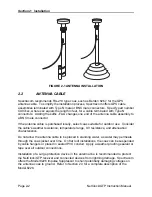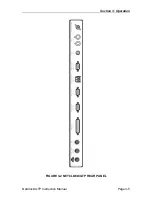
Section 2: Installation
NetClock/GTP Instruction Manual
Page 2-15
An example response is shown below:
TIME= 16:00:00 DATE= 2000-05-11 QUALIFIED HISTOGRAM
0= 00000 1= 00026 2= 00287 3= 03287 4= 00000
5= 00000 6= 00000 7= 00000 8= 00000 Q= 03600
TIME= 17:00:00 DATE= 2000-05-11 QUALIFIED HISTOGRAM
0= 00000 1= 00000 2= 00429 3= 02292 4= 00879
5= 00000 6= 00000 7= 00000 8= 00000 Q= 03600
TIME= 18:00:00 DATE= 2000-05-11 QUALIFIED HISTOGRAM
0= 00000 1= 00087 2= 00693 3= 02761 4= 00059
5= 00000 6= 00000 7= 00000 8= 00000 Q= 03600
TIME= 19:00:00 DATE= 2000-05-11 QUALIFIED HISTOGRAM
0= 00026 1= 00382 2= 00947 3= 02245 4= 00000
5= 00000 6= 00000 7= 00000 8= 00000 Q= 03574
TIME= 19:49:45 DATE= 2000-05-11 QUALIFIED HISTOGRAM
0= 00000 1= 00267 2= 01374 3= 01344 4= 00000
5= 00000 6= 00000 7= 00000 8= 00000 Q= 02985
In this example, the receiver tracked one satellite for 26 seconds, two satellites for 287
seconds and three satellites for 3287 seconds for the hour ending 16:00:00. The "Q"
value of 3600 indicates the receiver had tracked at least one qualified satellite for the
entire hour (3600 seconds). Note the partial histogram shown in the time stamp of
19:49:45.
For optimum performance, the receiver should consistently track three or more
satellites. The Q value should typically be 3600 for most entries. Occasional drops
below 3600 are considered acceptable. If the majority of the histograms show tracking
less than three satellites or Q values less than 3000, the receiver may not provide
reliable operation. Refer to Section 5.1,
Reception Troubleshooting
, for
recommendations.
















































